Beyond Brick and Steel: Unveiling the Magic of Industrial Restaurant Design

Table of Contents
Industrial restaurant design has become a captivating trend in the realm of interior design, captivating both restaurateurs and patrons alike.
This unique design style draws inspiration from industrial spaces like factories, warehouses, and lofts, creating an edgy and urban ambiance within dining establishments.
With its raw and unrefined aesthetic, industrial restaurant design has gained immense popularity in the restaurant industry.
One of the primary appeals of industrial design lies in its ability to create a distinctive atmosphere that stands out from traditional restaurant designs.
The combination of exposed brick walls, concrete floors, metal accents, and open ceilings gives industrial-style restaurants a sense of authenticity and character.
This departure from conventional aesthetics offers an immersive and memorable experience for diners, making it an attractive choice for restaurant owners looking to make a bold statement.

Moreover, industrial restaurant design caters to a broad range of culinary concepts and themes.
Whether it’s a trendy café, a contemporary bar, or a modern fine-dining establishment, the industrial style can be adapted and customized to suit various restaurant types.
Beyond its aesthetic appeal, industrial design offers practical benefits for restaurant owners.
The use of raw and durable materials not only contributes to the visual charm but also ensures long-lasting durability and ease of maintenance.
The spacious layout and open floor plans associated with industrial design allow for flexible seating arrangements, accommodating different group sizes and enhancing the overall flow of the restaurant.
In the following sections, we will delve deeper into the key elements and principles of industrial design, providing insights and guidance for those looking to incorporate this style into their own restaurant projects.
II. What is Industrial Design Style?

Industrial design style extends beyond the realm of restaurant design and finds its roots in a broader context.
In this section, we will provide an overview of the industrial design style, exploring its origins, evolution, and key features.
Understanding the essence of industrial design will help us appreciate its application in the restaurant industry.
- Overview of Industrial Design Style:
Industrial design is a discipline that encompasses the creation of products, environments, and experiences that prioritize functionality, usability, and aesthetics.
It emerged during the industrial revolution as a response to the mass production of goods and the need for well-designed, practical solutions.
- Origins and Evolution:
Industrial design finds its origins in the late 19th and early 20th centuries when the manufacturing industry was booming.
Designers like Henry Dreyfuss and Raymond Loewy played significant roles in establishing the principles and philosophy of industrial design.
They sought to create products that were not only visually appealing but also practical, efficient, and user-friendly.
Over time, industrial design has evolved to embrace a broader range of industries and applications.
From household appliances and furniture to transportation and architecture, the principles of industrial design have shaped various aspects of our daily lives.
- Key Features of Industrial Design Style:
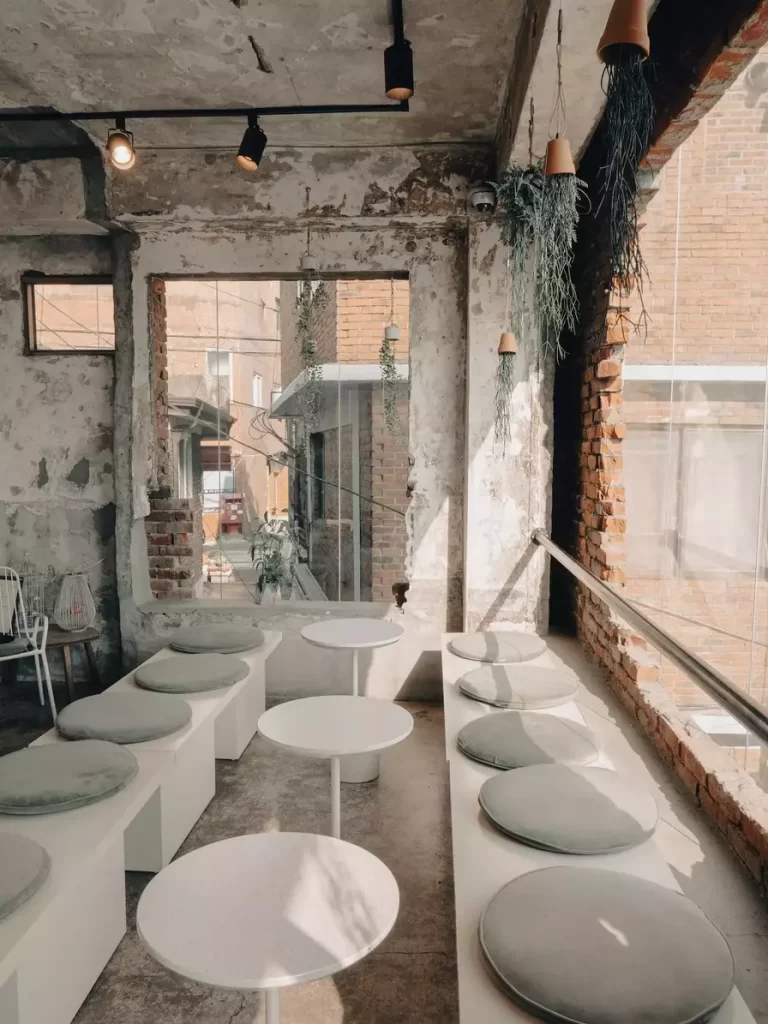
Simplicity: Industrial design emphasizes clean lines, minimal ornamentation, and simplicity of form.
It avoids unnecessary embellishments and focuses on essential elements, giving products and spaces a sleek and uncluttered appearance.
Functionality: Functionality is at the core of industrial design.
Every element and detail serves a purpose and is designed to enhance usability.
Industrial-style products and spaces prioritize practicality and efficiency, ensuring that they meet the needs of users.
Integration of Industrial Materials: Industrial design celebrates the use of materials typically associated with industrial settings, such as metal, concrete, glass, and reclaimed wood.
These materials are appreciated for their durability, honesty, and industrial aesthetic, adding character and authenticity to the design.
Emphasis on Craftsmanship: Despite its focus on functionality and simplicity, industrial design acknowledges the importance of craftsmanship.
Attention is given to the quality of materials, precision in manufacturing, and the details that contribute to the overall user experience.
Timelessness: Industrial design often exhibits a timeless quality, transcending trends and fads.
The emphasis on functionality and simplicity allows industrial-style products and spaces to stand the test of time and remain relevant for years to come.
III. What is Industrial Style Restaurant?

Industrial style in restaurant design is characterized by its rugged, raw, and unfinished look, inspired by industrial spaces such as factories, warehouses, and workshops.
It embraces the imperfections of materials and celebrates the beauty of functionality.
Here, we will explore the key characteristics and elements of industrial style and discuss how they influence the overall atmosphere and ambiance of a restaurant.
1-Characteristics and Elements:
Raw Materials:

Industrial-style restaurants prominently feature raw and natural materials, such as exposed brick walls, weathered wood, concrete floors, and unfinished metal surfaces. These materials evoke a sense of authenticity and create a raw, industrial charm.
Exposed Infrastructure:

Industrial aesthetics often celebrate the structural elements that are typically concealed in traditional designs.
Exposed ductwork, beams, and pipes become design features in their own right, adding visual interest and depth to the space.
Metal Accents:

Industrial design incorporates metal accents as a key element.
From industrial lighting fixtures with exposed bulbs to metal furniture and fixtures, the presence of metal adds a touch of ruggedness and industrial character to the restaurant.
Open Spaces:

Industrial restaurants tend to embrace open layouts, with high ceilings and expansive spaces.
This design choice not only enhances the industrial feel but also allows for flexible seating arrangements, accommodating various group sizes and promoting a sense of freedom and openness.
2-Influence on Atmosphere and Ambiance:
Authenticity:

The use of raw materials and exposed elements creates an authentic and genuine ambiance that resonates with customers.
The industrial aesthetic appeals to those seeking a departure from traditional designs, providing a unique and memorable dining experience.
Urban and Edgy Vibes:

Industrial restaurants exude an urban and edgy vibe, attracting a diverse clientele.
The rough textures, industrial lighting, and utilitarian furnishings contribute to a trendy and contemporary atmosphere that appeals to a modern audience.
Warmth and Coziness:

Despite its raw and unfinished appearance, an industrial design can still evoke a sense of warmth and coziness.
Strategic use of lighting, soft textiles, and warm color accents can balance the industrial elements and create a comfortable and inviting environment for diners.
Versatility:

Industrial design can be adapted to various culinary concepts, from casual cafes to upscale eateries.
The style’s versatility allows restaurant owners to infuse their own unique vision and branding into the space while maintaining the industrial aesthetic.
An industrial restaurant embraces raw materials, exposed infrastructure, metal accents, and open spaces. These elements work together to create an authentic, urban, and edgy atmosphere that appeals to a wide range of diners.
The combination of industrial aesthetics with warmth and coziness makes it a versatile design choice for restaurant owners seeking to make a statement and offer a memorable dining experience.
IV. How Can You Design an Industrial Restaurant?
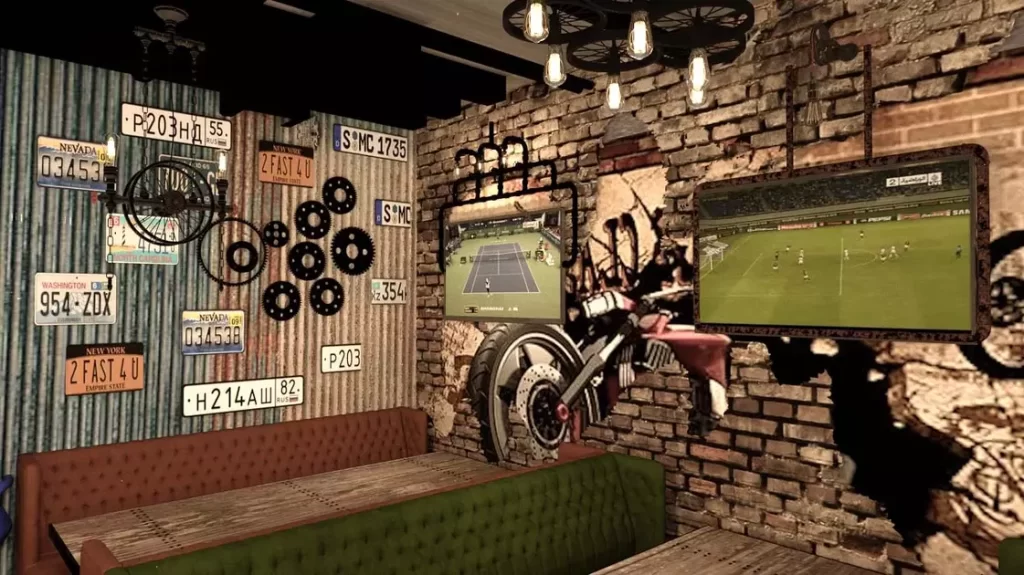
Designing an industrial restaurant requires careful planning and attention to detail.
In this section, we will discuss the importance of a well-defined concept and theme for an industrial restaurant.
We will also provide practical tips for incorporating industrial elements into the restaurant design, ensuring a cohesive and captivating space.
- Well-Defined Concept and Theme:
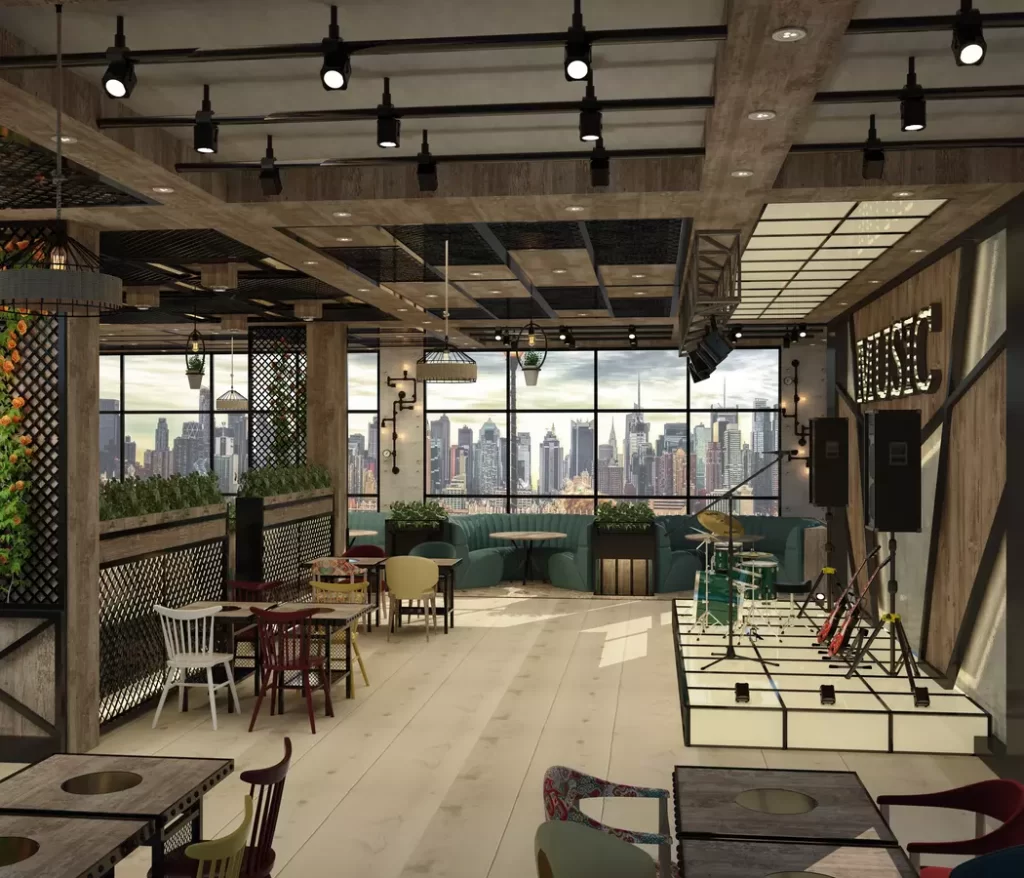
Establish a Clear Vision:

Start by defining the overall concept and theme of your industrial restaurant.
Consider the type of cuisine, target audience, and desired atmosphere.
This clarity will guide your design decisions throughout the process.
Research and Gather Inspiration:

Immerse yourself in industrial design aesthetics by researching and gathering inspiration from various sources.
Explore industrial-themed restaurants, architectural magazines, and online platforms to spark ideas and develop a vision for your space.
2. Create a Layout that Maximizes Space and Flow:

Assess the available space and create a layout that maximizes functionality and flow.
Consider factors such as the kitchen location, bar placement, and seating arrangements.
Aim for an open and spacious feel, utilizing the industrial aesthetic to enhance the overall design.
Ensure there is a smooth flow for both customers and staff.
3. Incorporating Industrial Elements:
- Selecting the Right Color Palette and Materials:

Pick a color scheme that goes well with the industrial style.
Neutral tones, such as shades of gray, beige, and brown, work well as a base.
Introduce pops of color through accents or artwork.
When it comes to materials, opt for exposed brick, concrete floors, weathered wood, and metal finishes to create an authentic industrial look.
- Exposed Brick, Concrete, and Metal Accents:

Uncovered brick walls are a defining feature of industrial style.
Retain or uncover existing brickwork, or introduce faux brick panels if needed.
Utilize concrete floors or opt for concrete-look tiles.
Incorporate metal accents through fixtures, furniture, and structural elements, such as exposed beams or piping.
- Industrial Lighting Fixtures and Furniture:
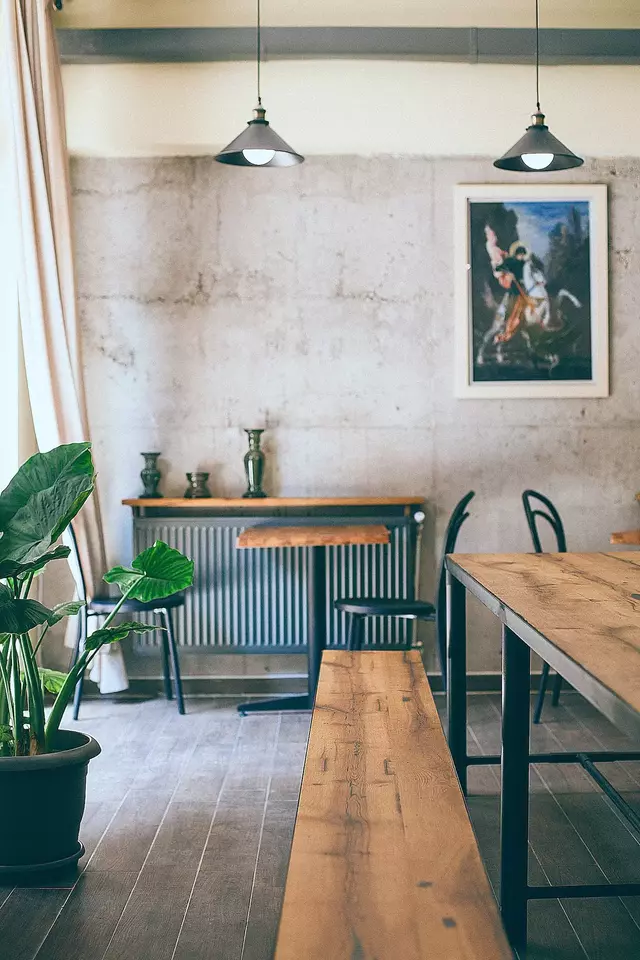
Lighting plays a crucial role in industrial design.
Choose industrial-style lighting fixtures with exposed bulbs, metal shades, or wire cages.
Pendant lights, track lighting, and industrial chandeliers are popular choices.

Similarly, select furniture with an industrial aesthetic, such as metal chairs, reclaimed wood tables, and industrial-style bar stools.
- Balancing Aesthetics with Comfort and Functionality:
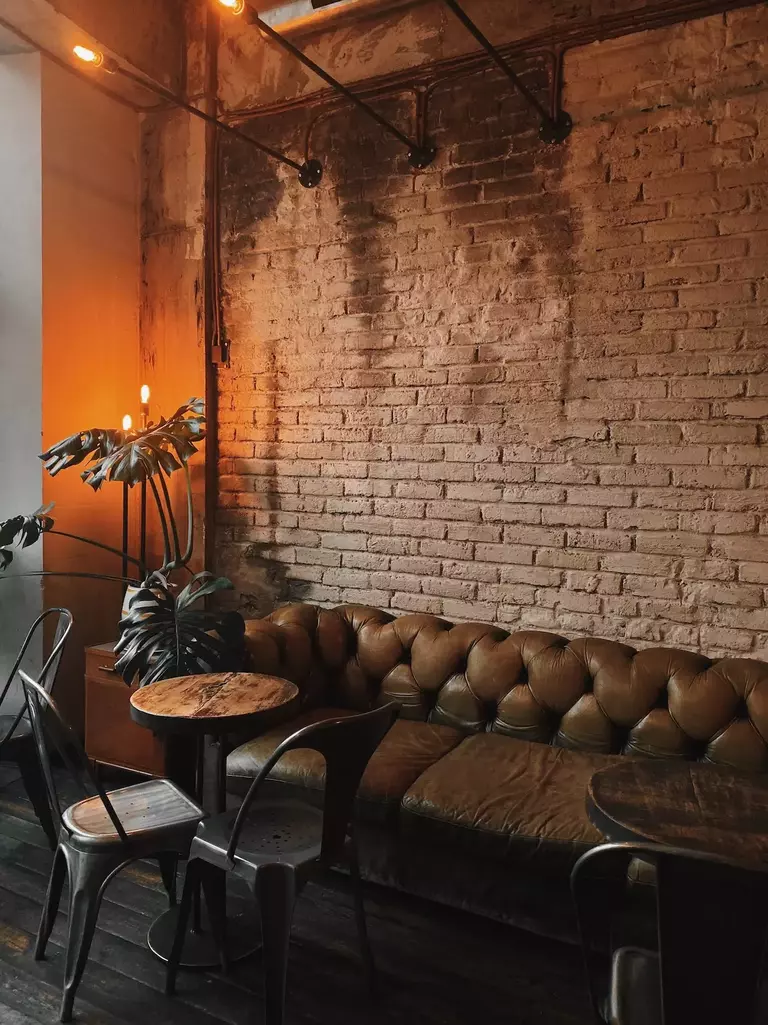
While industrial design emphasizes aesthetics, it’s important to strike a balance between comfort and functionality.
Incorporate comfortable seating options and consider acoustics to ensure a pleasant dining experience.
Soften the industrial look with textiles like upholstered booths, cushions, and curtains.
Integrate sound-absorbing materials to minimize noise levels.
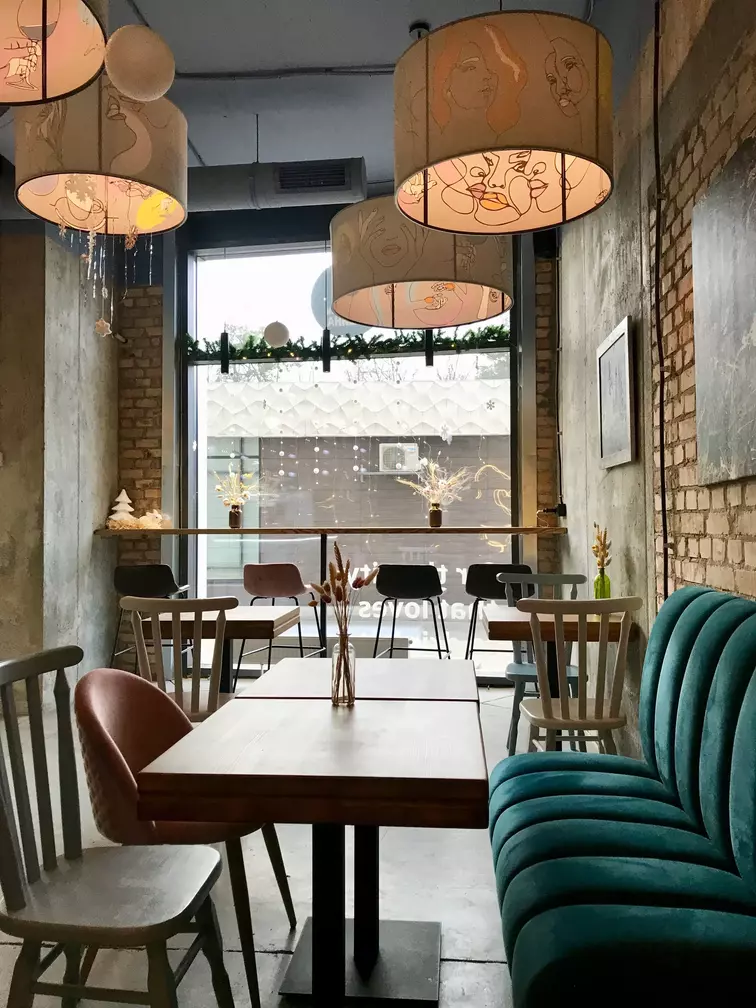
Remember that creating an industrial restaurant is not about replicating a factory or warehouse, but rather capturing the essence and elements of industrial design while providing a comfortable and enjoyable dining environment.
By following these practical tips and paying attention to detail, you can design an industrial restaurant that seamlessly integrates industrial elements, creating a visually captivating and inviting space for your patrons.
In conclusion, Industrial-style restaurant design offers a captivating and unique ambiance that has gained popularity in the industry.
By incorporating raw materials, exposed brick, metal accents, and open spaces, you can create an outstanding dining space.
Thoughtful industrial design enhances the overall dining experience and leaves a lasting impression on customers.
Apply these principles to your own projects to create a visually striking and memorable restaurant that sets itself apart in the competitive market.
